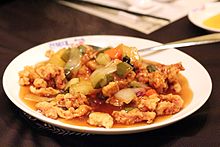 | |
| Place of origin | Korea |
|---|---|
| Region or state | Incheon Chinatown |
| Associated cuisine | Korean Chinese cuisine |
| Created by | Chinese immigrants in Korea [1] |
| Serving temperature | Warm |
| Main ingredients | Pork or beef loin, sweet and sour sauce |
| Korean name | |
| Hangul | |
|---|---|
| Hanja | |
| Revised Romanization | tangsuyuk |
| McCune–Reischauer | t'angsuyuk |
| IPA | [tʰaŋ.su.juk̚] |
Tangsuyuk ( Korean: 탕수육) is a Korean Chinese meat dish with sweet and sour sauce. It can be made with either pork or beef. [3] [4] [5]
History and etymology
Tangsuyuk is a dish that was first made by Chinese merchants in the port city of Incheon, where the majority of the ethnic Chinese population in contemporary South Korea live. It is derived from the Shandong-style sweet and sour pork, as Chinese immigrants in Korea, including those that had first migrated to Northeastern China (which is known for Guōbāoròu, a similar sweet and sour pork dish), mostly had Shandong ancestry. [1]
Although the Chinese characters meaning " sugar" (糖), " vinegar" (醋), and " meat" (肉) in the original Chinese name "糖醋肉 (pronounced tángcù ròu in Chinese)" are pronounced dang, cho, and yuk in Korean, the dish is called tangsuyuk, not dangchoyuk, because the word tangsu derived from the transliteration of Chinese pronunciation tángcù [tʰǎŋ.tsʰû], with the affricate c [tsʰ] in the second syllable weakened into fricative s [s]. [6] Transliterated loanwords like tangsu do not comprise Sino-Korean vocabulary and do not carry hanja.
The third syllable ròu (肉) was not transliterated, as Sino-Korean word yuk (육; 肉) meaning "meat" was also commonly used in Korean dish names. [6]
As the word tangsuyuk is the combination of transliterated loanword tangsu and Sino-Korean yuk, it was not a Sino-Korean vocabulary that could be written in hanja. However, Koreans back-formed the second syllable with hanja su (수; 水), meaning "water", perhaps because the sauce was considered soupy. [3]
Preparation
Bite-size pieces of pork or beef loin are coated with batter, usually made by soaking a mixture of potato or sweet potato starch and corn starch in water for several hours and draining the excess water. Glutinous rice flour may also be used. Egg white or cooking oil is added to the batter to change its consistency. Similarly to other Korean deep fried dishes, battered tangsuyuk meat is double-fried. [7] [8]
Tangsuyuk is served with sweet and sour sauce, which is typically made by boiling vinegar, sugar and water, with variety of fruits and vegetables like carrot, cucumber, onion, water chestnut, wood ear mushroom and pineapple. Starch slurry is used to thicken the sauce. [7]
Gallery
-
Beoseot-tangsuyuk, a vegan/vegetarian tangsuyuk dish using shiitake mushroom as a meat substitute
See also
References
- ^ a b 김, 경운 (26 February 2016). "짜장면과 탕수육". Seoul Shinmun (in Korean). Retrieved 21 April 2017.
- ^ "bulgogi" 불고기. Korean Food Foundation (in Korean). Retrieved 8 April 2017.
- ^ a b "tangsuyuk" 탕수육. Standard Korean Language Dictionary (in Korean). National Institute of Korean Language. Retrieved 21 April 2017.
-
^ L, Sue (4 November 2018).
"Tangsuyuk (Sweet and Sour Beef or Pork)". Korean Bapsang. Retrieved 4 April 2022.
Tangsuyuk (also spelled tangsooyuk) is another beloved Korean-Chinese dish along with the two noodle dishes – jajangmyeon and jjamppong.
-
^ S, Hyosun (11 March 2017).
"Tangsuyuk". My Korean Kitchen. Retrieved 4 April 2022.
Tansuyuk / Tang soo yook / Tang su yuk (탕수육, 糖醋肉) is a very popular Korean Chinese dish known as Korean sweet and sour pork.
- ^ a b 임, 대근 (10 June 2016). "탕수육은 왜 탕수육일까?". Pressian (in Korean). Retrieved 21 April 2017.
- ^ a b Ro, Hyo-sun (28 March 2014). "Tangsuyuk (sweet and sour pork)". The Korea Herald. Retrieved 21 April 2017.
- ^ Joo, J. (2016). Korean Food Made Simple. Houghton Mifflin Harcourt. p. 183. ISBN 978-0-544-66308-4. Retrieved April 25, 2017.
